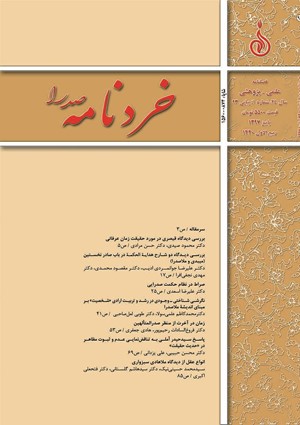پاسخ سيدحيدر آملي به تناقضنمايي عدم و ثبوت مظاهر در «حديث حقيقت»
محورهای موضوعی :
1 - دانشگاه علامه طباطبايي
2 - دانشگاه علامه طباطبائي
کلید واژه: حديث حقيقت تناقضنما ثبوت عدم مظاهر امام علي(ع) سيدحيدر آملي ,
چکیده مقاله :
«حديث حقيقت» كه كميل از امام علي (ع) نقل كرده، مضامين عاليهيي دارد و بزرگاني همچون سيدحيدر آملي بر آن شرح نوشته است. آملي در تفسير فقرة اول حديث، يعني «الحقيقة كشف سبحات الجلال من غير اشارة» به اين موضوع اشاره ميكند كه طبق اين حديث، حق تعالي در صور مظاهر ظهور دارد و در عينحال، اين مظاهر معدومند. اين جمله متناقضنما (پارادوكسيكال) است ولذا سيد حيدر در پي حل آن برآمده است. از نظر او مظاهر و ماهيات در عدم خود ثابتند و به اسم «نور الهي» كه همان وجود حق تعالي است، ظاهر ميشوند. آنها دائماً در عدمند و اين اسم ظاهر الهي است كه آن به آن، به آنها وجود ميدهد وگرنه اگر دائماً موجود باشند، وجود دادن به آنها تحصيل حاصل خواهد بود. او در پاسخ به اين امر تناقضنما، از تمثيل دريا و موج بهره برده است. دريا در قالب موج نمود پيدا ميكند، پس موج از جهتي هست و از جهتي نيست. با اين توضيح سيدحيدر سعي كرده تناقضنمايي در فقره» اول حديث را مرتفع سازد.
The “Hadith of Truth”, which Kumayl has narrated from Imam Ali (a), contains some sublime points, and on which some prominent figures such as Seyyed Haydar Amuli have written commentaries. When commenting on the first part of the hadith, “al-haqiqah …”, Amuli mentions that, according to this hadith, Almighty Truth is manifested in the forms of the loci of manifestations, which are, nevertheless, non-existent. This statement appears paradoxical and, thus, Seyyed Haydar has tried to resolve it. In his view, manifestations and entities are fixed in their non-existence and appear in the name of “divine light”, which is the same existence of Almighty Truth. They are permanently in non-existence, and it is, in fact, the name of the divinely manifested that grants them existence at each moment. Otherwise, if they enjoy continuous existence, granting existence to them would mean the attainment of what they have already attained. In response to this paradoxical affair, Amuli benefits from the allegory of the sea and the wave. He explains that the sea appears in the form of the wave; hence, the wave exists in one respect and does not exist in another one. In this way, Seyyed Haydar tries to remove the paradox involved in the first section of the hadith.
قرآن كريم. نهجالبلاغه، ترجمة علينقي فيضالاسلام، تهران، فقيه، 1379.
آشتياني، سيدجلالالدين، شرح مقدمه قيصري، تهران، اميركبير، 1370.
آشتياني، سيدجلالالدين، «مقدمه»، در: زنوزي، عبدالله، انوار جليه در كشف اسرار حقيقت علويه، تهران، اميركبير، 1371.
آملي، سيدحيدر، المقدمات من كتاب نص النصوص، تهران، انستيتو ايران و فرانسه، 1352.
آملي، سيدحيدر، تفسير المحيط الاعظم، تهران، وزارت فرهنگ و ارشاد اسلامي، 1422ق.
آملي، سيدحيدر، جامع الاسرار و منبع الانوار، تهران، علمي و فرهنگي، 1368.
آملي، سيدحيدر، نقد النقود في معرفةالوجود، تهران، علمي و فرهنگي، 1368.
ابنمنظور، ابوالفضل جمالالدين محمد بن مكرم، لسان العرب، بيروت، دار صادر، 2013م.
اربابون، حسين، «قضاياي پارادوكسيكال در انديشة صدرالدين دشتكي و رياضيدانان معاصر»، مجموعه مقالات يازدهمين و دوازدهمين همايش بزرگداشت حكيم صدرالمتالهين شيرازي (ملاصدرا)، تهران، بنياد حكمت اسلامي صدرا، 1387.
استيس، والتر، عرفان و فلسفه، ترجمة بهاءالدين خرمشاهي، تهران، سروش، 1392.
بستاني، فؤاد افرام، فرهنگ ابجدي عربي به فارسي، ترجمة رضا مهيار، تهران، اسلامي، 1376.
بيدهندي، محمد، «بررسي و تحليل مفهوم حقيقت در انديشة ملاصدرا و هيدگر»، خردنامه صدرا، ش45، پاييز 1385، ص31ـ15.
حبيبي، محسن؛ رضايي، صادق، «معناي حقيقت از منظر حكماي مسلمان با تأكيد بر آثار ابنعربي»، فصلنامه تاريخ فلسفه، ش24، بهار 1395، ص128ـ101.
خوانساري، محمد، فرهنگ اصطلاحات منطقي، تهران، پژوهشگاه علوم انساني و مطالعات فرهنگي، 1376.
زنوزي، عبدالله، انوار جليه در كشف اسرار حقيقت علويه، مقدمه و تحصيح سيدجلالالدين آشتياني، تهران، اميركبير، 1371.
شاپوري، سعيد، «فهم از حقيقت نزد پيشاسقراطيان»، فصلنامه تاريخ فلسفه، ش 19، زمستان 1393، ص176ـ159.
شهرزوري، شمسالدين محمد، شرح حكمةالاشراق، تصحيح حسين ضيائي، تهران، مؤسسة مطالعات و تحقيقات فرهنگي، تهران، 1372.
قاسمي، جواد، فرهنگ اصطلاحات فلسفه، كلام، منطق، مشهد، آستان قدس رضوي، 1388.
قرشي، علياكبر، قاموس قرآن، تهران، كتابفروشي اسلاميه، 1367.
كاشاني، عبدالرزاق، مجموعه رسايل و مصنفات كاشاني، تهران، ميراث مكتوب، 1380.
يزدانپناه، سيد يدالله، مباني و اصول عرفان نظري، قم، مؤسسة آموزشي و پژوهشي امام خميني، 1389.
